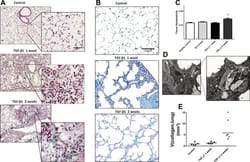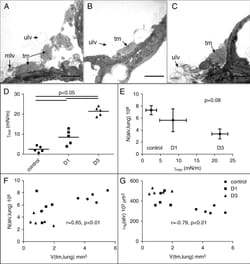Birkelbach, B., Lutz, D., Ruppert, C., Henneke, I., Lopez-Rodriguez, E., Günther, A., Ochs, M., Mahavadi, P., Knudsen, L.: Am J Physiol-Lung C. 2015;309(1):L63-75
To access the full article, click here:

Chronic injury of alveolar epithelial type II cells (AE2 cells) represents a key event in the development of lung fibrosis in animal models and in humans, such as idiopathic pulmonary fibrosis (IPF). Intratracheal delivery of amiodarone to mice results in a profound injury and macroautophagy-dependent apoptosis of AE2 cells. Increased autophagy manifested in AE2 cells by disturbances of the intracellular surfactant. Hence, we hypothesized that ultrastructural alterations of the intracellular surfactant pool are signs of epithelial stress correlating with the severity of fibrotic remodeling. With the use of design-based stereology, the amiodarone model of pulmonary fibrosis in mice was characterized at the light and ultrastructural level during progression. Mean volume of AE2 cells, volume of lamellar bodies per AE2 cell, and mean size of lamellar bodies were correlated to structural parameters reflecting severity of fibrosis like collagen content. Within 2 wk amiodarone leads to an increase in septal wall thickness and a decrease in alveolar numbers due to irreversible alveolar collapse associated with alveolar surfactant dysfunction. Progressive hypertrophy of AE2 cells and increase in mean individual size and total volume of lamellar bodies per AE2 cell were observed. A high positive correlation of these AE2 cell-related ultrastructural changes and the deposition of collagen fibrils within septal walls were established. Qualitatively, similar alterations could be found in IPF samples with mild to moderate fibrosis. We conclude that ultrastructural alterations of AE2 cells including the surfactant system are tightly correlated with the progression of fibrotic remodeling.




